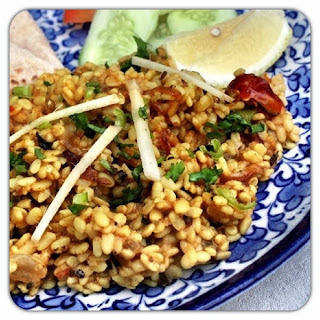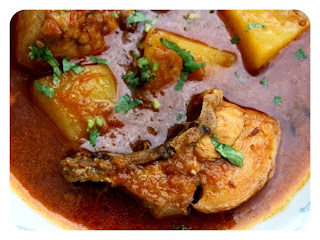Daal Maash was abbu’s favorite.
Ammi used to cook it frequently during winter days. Fast forward many years, my husband cannot get enough of daal Maash. I love all Lentils but somehow I never quite
liked daal Maash. Daal Maash has a very distinct nutty flavor which my taste
buds could not appreciate as a kid. There were many foods many of us did not
appreciate as kids, growing up changed that for most of us. Daal Maash, French beans and Spinach were less
favored foods for me back then.
This particular Daal Maash recipe
belongs to my Mother-in-law. Her simple technique brings out the best of Maash
daal’s flavor. I remember the left over Maash daal was always made in to a paratha
the next morning for breakfast. The cooked lentils were stuffed between two
layers of flat bread and cooked with desi ghee (clarified butter) or butter and
eaten with copper colored sweet chai – tea as the mercury hovered around
freezing point. I never said no to maash lentil paratha. I still make a paratha
out of left over Daal Maash the next day and have it with sweet chai like old
times. Somehow it transports me back to ammi’s house in winters. This is served with Home made Chappati - Flat bread. Here is the
recipe.
Ingredients:
Maash Lentil – ¾ cup – soaked overnight
Onion – 1 Large – chopped in small
cubes (save 1/4th for Tarka- Oil tempering)
Oil – 2 Tbsps.
Fresh Tomato Puree – ¾ cup
Fresh Ginger & Garlic paste –
1 tsp. (Heaped)
Cumin seeds – 1 tsp. (heaped –
gently crushed in pestle mortar)
Whole coriander seeds – 1 tsp.
(Heaped – Gently crushed in pestle mortar)
Whole dried chilies- 2
Salt – ¾ tsp. (taste and add more
if needed).
Chili powder – ¾ tsp. (taste and
add more if needed).
Turmeric – ¼ tsp.
Cumin powder – ½ tsp.
Water – 1 cup
Dried Kasuri Methi (Dried
Fenugreek Leaves) – 1 tsp. (Heaped)
For Tarka –Oil tempering:
Oil – 1 Tbsps.
Onion – ¼ of a large onion –
thinly sliced.
Ginger – 1 Inch Julienne cut
Green chili – 1 medium – chopped
Fresh Coriander – chopped (for garnish).
Method:
- Heat the oil in a medium sized pan that should have a lid. Add onions and let them turn translucent. Do not brown them.
- Add crushed Cumin seeds, crushed coriander seeds and whole dried chilies. Cook for 1 minute on medium to high heat.
- Add drained Maash Lentil. Cook on high heat till the water dries up.
- Add tomato puree, ginger-garlic paste, salt, chili powder, turmeric and cumin powder. Mix and cook for about one minute.
- Add one cup of water and let it come up to a boil. Once it starts boiling, reduce the heat to a simmer, cover with the lid and let it cook for 45 mins. Check after 20-25 mins. Lentils in different places take different amount of time to cook. In Pakistan Maash lentil is cooked in about 25-30 mins. In my current location I need about 40-45 mins to cook it despite soaking it overnight. Keep an eye on it as it cooks.
- Once the water has dried up and Lentil has cooked completely, add the dried Kasuri Methi to it and mix. Switch off the stove.
- Now prepare the tarka. Heat the oil in a small frying pan and fry onions till gently golden. Add Julienne ginner and green chilies to it. Add it to the lentil. I had fished the fried items and added them to the lentil leaving out the oil in the frying pan to control the calorie count. If you are not worried about calories then feel free to add the oil as well.
- Garnish with Fresh green coriander and thinly chopped green chili.
Maash Lentil is
paired beautifully with fresh roti/ chappati and Mint chutney with a tomato,
cucumber, onion salad. Don’t forget to make a paratha out of the left overs the
next day and have it with sweet chai.






























.jpeg)
.jpeg)

















